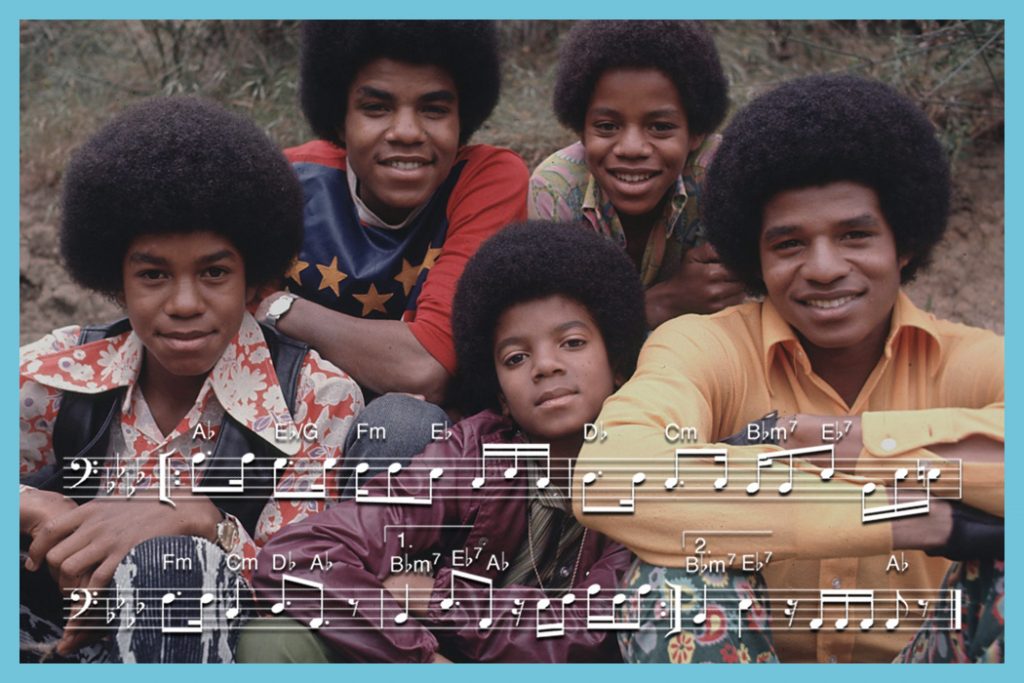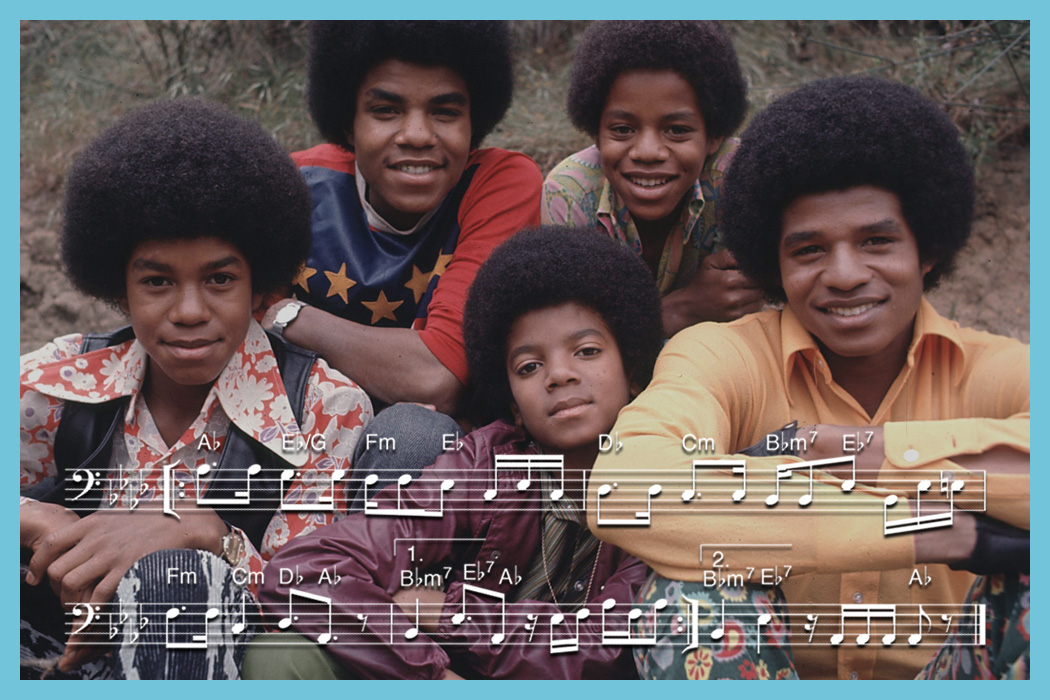+ Bridge the worlds of theory, improvisation, and jazzy hip-hop, and improve your piano chops with Grammy-winner Kiefer in his course, Kiefer: Keys, Chords, & Beats.
This is an updated version of an article that appears on Ethan Hein’s blog.
We think of descending melodies and chord progressions as being sad. But arguably the happiest song of all time also has a descending progression: “I Want You Back” by the Jackson 5.
This recording was made just after Michael’s eleventh birthday. I do not approve of child labor, and making a prepubescent boy sing all these songs about romantic love ended up having some grim long-term psychological consequences. But, man, what a performance.
Like all early Jackson 5 songs, this was written by “The Corporation,” Berry Gordy’s team of professional songwriters at Motown. The backing track was performed by ace jazz-trained session musicians. Here’s Wilton Felder’s isolated bass part:
The YouTube video shows a picture of a saxophonist because Felder played that instrument in the Jazz Crusaders. He also played bass on records by Marvin Gaye, Grant Green, Seals and Crofts, Billy Joel, John Cale, Randy Newman, Joan Baez, and Joni Mitchell.
Here’s my transcription of the bassline and the chords. There are lots of little figures in here that seem like ornaments, but Felder plays them the same way every time, meaning that he considered them to be integral to the melody.
The chords are not nearly as complicated as they look. They’re all derived from the A♭ major scale, using a simple formula that I’ve represented with the graphic below.
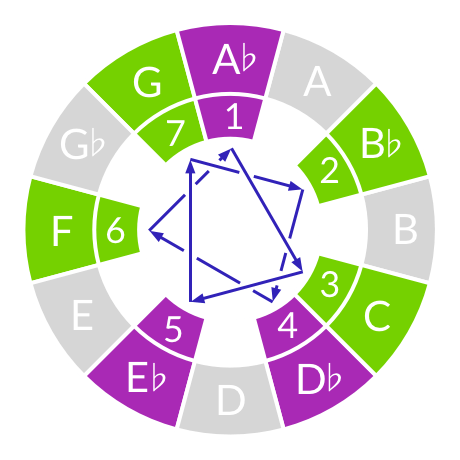
To make a chord, you start on a scale note, for example, A♭. You skip a scale degree to land on C. Then, you skip another scale degree to land on E♭. That makes an A♭ chord. To make a B♭ chord, you start on B♭, skip a scale degree to land on D♭, and skip another one to land on F.
You can build chords from any degree of the scale this way. The ones with purple roots are major, and the ones with green roots are minor (except for the seventh, G, which is half diminished, you don’t care.) “I Want You Back” uses chords built on all the notes of the scale except for the seventh. The whole song just jumps around this harmonized version of the A♭ major scale.
The useful thing about the major scale is that all the chords it generates sound good in any order and any combination. That said, not every combination and sequence is equally satisfying. To understand why “I Want You Back” is so cool, it helps to see the scale written on the Circle of Fifths — intriguingly, when written this way, the notes in the major scale are all grouped consecutively.
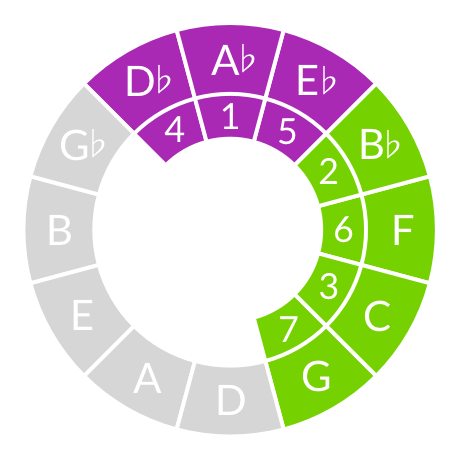
Western listeners hear things that are close together on the circle of fifths as being related to each other. We especially like it when chord roots go sequentially around the circle of fifths. In classical music, they usually go counterclockwise; in pop, they can go either way. When you look at the chords in “I Want You Back,” there’s a lot of circle of fifths root movement in both directions. This kind of classically functional harmony is a little unusual in the music popular among black artists and audiences at the time, and I’m wondering if Berry Gordy’s team chose it specifically so that the song would appeal to white people.
+ Learn production, composition, songwriting, theory, arranging, mixing, and more — whenever you want and wherever you are. Subscribe for unlimited access!

The third and fourth bars of each section have a particularly gratifying Bach-like harmonic logic to them — it’s the part underneath “Won’t you please let me back in your heart.” The chords here are changing every quarter note, which is an unusually fast harmonic rhythm for a pop song. The overall root motion is downward, but with lots of jumping around. The chord progression is Fm-Cm-Db-A♭, B♭m7-E♭7-A♭.
When you step through these chords in pairs, they show all kinds of fascinating structure:
- Fm-Cm: a plagal cadence in C minor
- Cm-D♭: the root moves up a half-step, which has a cadence-like feeling
- D♭-A♭: a plagal cadence in A♭ major
- A♭-B♭m: the root goes up a whole step, which is sort of a backwards plagal cadence in A♭ major
- B♭m-E♭7: a v-I “cadence” in E♭ Mixolydian
- E♭7-A♭: a classical-style authentic cadence in A♭ major
If the chords aren’t as complicated as they seem, the rhythm is more complicated than it seems. “I Want You Back” is a really tough groove to get right. To understand why, you need to know what syncopation is. You can subdivide a measure of 4/4 time in half, then in half again, then again, and so on, like so:
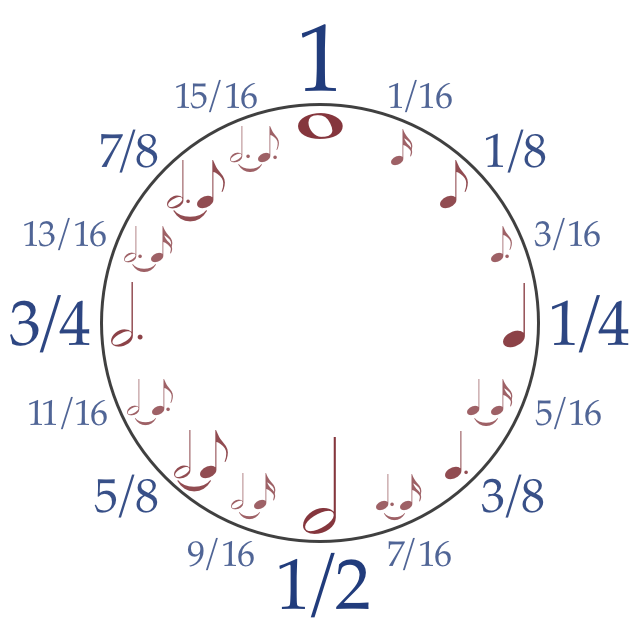
The more finely you subdivide the bar, the more complicated your rhythms can be. Beats that fall on the more coarse-grained divisions are felt as “stronger,” while beats on the finer subdivisions are “weaker.” Syncopation is the effect of unexpectedly accenting the weak beats. The more times you have to divide the bar in half to get to a given beat, the weaker it is, and the weaker the beats are that you’re accenting, the more complex the rhythm is. “I Want You Back” is full of accents on the weakest beats.
The effect of syncopation is especially pronounced when you accent a weak beat that’s very close to one of the strongest beats, especially the downbeat, the strongest beat of them all. At the end of the very first bar of the bass line, there’s an accent on the last sixteenth note of the bar, which is very close to the following downbeat and thus an ear-grabbing surprise. All the way around, this groove is so solid that it works fine if you replace all the notes with A-flat. Try it!
Classical music usually does rhythmic complexity by changing the underlying meter and phrase length a lot, but playing predictable beats within that changing framework. Modern music (derived in large part from the influence of African-American artists and musicians) usually keeps the underlying meter the same over the entire duration of a song, and uses syncopation to keep things sounding interesting.
Most listeners in the past hundred years have come to prefer the African-American strategy because it’s friendlier to audience participation. No matter how complicated a funk groove is, there’s the very predictable 4/4 underlying it, and even untrained listeners can follow along. If the meter is changing all the time, there’s no way to predict or follow it unless you have the piece memorized or are reading along in the score.
So, why is “I Want You Back” so joyful?
Functional major scale harmony usually reads as happy. Uptempo funk absolutely reads as happy. The overall emotion comes from the interaction of both those components, along with the arrangement and the raw exuberance of everyone’s performance, from Michael on down. Change one aspect of the song and the whole mood changes. For example, Janelle Monáe’s cover is only slightly slower and more relaxed than the original, but its mood is totally different.
This is still happy, but it’s more wistful and abstract, less jump-out-of-your-chair exuberant. Monáe feels like she’s holding something back. The Jacksons leave everything they have in the recording booth, and that comes across.
Don’t stop here!
Keep learning about theory and harmony, composing and arranging, songwriting, and more, with Soundfly’s in-depth online courses. Subscribe for access to all, including The Creative Power of Advanced Harmony, Orchestration for Strings, and our exciting new course with Grammy-winning pianist and producer, Kiefer: Keys, Chords, & Beats.
